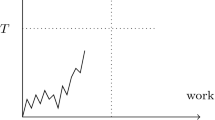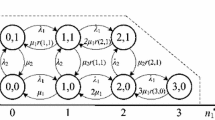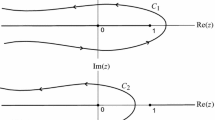Abstract
We consider a generalization of the classical Erlang loss model with both retrials of blocked calls and a time‐dependent arrival rate. We make exponential‐distribution assumptions so that the number of calls in progress and the number of calls in retry mode form a nonstationary, two‐dimensional, continuous‐time Markov chain. We then approximate the behavior of this Markov chain by two coupled nonstationary, one‐dimensional Markov chains, which we solve numerically. We also develop an efficient method for simulating the two‐dimensional Markov chain based on performing many replications within a single run. Finally, we evaluate the approximation by comparing it to the simulation. Numerical experience indicates that the approximation does very well in predicting the time‐dependent mean number of calls in progress and the times of peak blocking. The approximation of the time‐dependent blocking probability also is sufficiently accurate to predict the number of lines needed to satisfy blocking probability requirements.
Similar content being viewed by others
References
J.W. Cohen, Basic problems of telephone traffic theory and the influence of repeated calls, Philips Telecom. Rev. 18 (1957) 49–100.
G. Falin, A survey of retrial queues, Queueing Systems 7 (1990) 127–167.
D.L. Jagerman, Nonstationary blocking in telephone traffic, Bell System Technical Journal 54 (1975) 625–661.
F.P. Kelly, Loss networks, Ann. Appl. Probab. 1 (1991) 319–378.
A.Y. Khintchin, Mathematical methods in the theory of queueing, Trudy Math. Inst. Steklov. 49 (1955) (in Russian). English translation by Charles Griffin and Co., London (1960).
L. Kosten, On the influence of repeated calls in the theory of probabilities of blocking, De Ingenieur 59 (1947) 1–25 (in Dutch).
W.A. Massey and W. Whitt, An analysis of the modified offered load approximation for the nonstationary Erlang loss model, Ann. Appl. Probab. 4 (1994) 1145–1160.
C. Palm, Intensity variations in telephone traffic, Ericsson Technics 44 (1943) 1–189 (in German). English translation by North-Holland, Amsterdam (1988).
R. Syski, Introduction to Congestion Theory in Telephone Systems (North-Holland, Amsterdam, 2nd ed., 1986).
M.R. Taaffe and K.L. Ong, Approximating Ph(t)/M(t)/S/C queueing systems, Ann. Oper. Res. 8 (1987) 103–116.
W. Whitt, Blocking when service is required from several facilities simultaneously, AT&T Tech. J. 64 (1985) 1807–1856.
R.W. Wolff, Stochastic Modeling and the Theory of Queues (Prentice-Hall, Englewood Cliffs, NJ, 1989).
T. Yang and J.G.C. Templeton, A survey on retrial queues, Queueing Systems 2 (1987) 201–233.
Author information
Authors and Affiliations
Rights and permissions
About this article
Cite this article
Grier, N., Massey, W.A., McKoy, T. et al. The time‐dependent Erlang loss model with retrials. Telecommunication Systems 7, 253–265 (1997). https://doi.org/10.1023/A:1019176413237
Issue Date:
DOI: https://doi.org/10.1023/A:1019176413237




